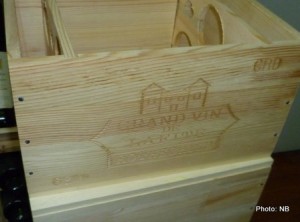
~
By Jim Boyce
This week UK wine writer Jancis Robinson will start posting a five-part series by Nick Bartman on fake wine in China. Who’s Nick Bartman? An investigator who started The Wine Protection Group a few years ago to encourage industry players to join forces and fight counterfeit wines. He says the plan didn’t work due to industry inertia and stopped his anti-counterfeiting work in China about a year ago.
I first came into contact with Bartman in January of 2010 and met him several times later that year and in 2012. Last year, I posted some points covered in our initial meetings. An excerpt:
Boyce: Where did you go during your five-week tour of China and what did it reveal to you about the scope of the fake wine problem?
Bartman: My itinerary included Beijing, Yantai, Qingdao, Guangzhou, Wenzhou, Shanghai and Ningbo. I visited retailers, including small shops and supermarkets, wineries, and even distributors that operate out of apartment buildings.
I estimate I saw 300 to 400 different fake wines during my five weeks in China. The more I look at my 2,000 pictures and study details on each label, the more that number increases.
With a few exceptions there were fake wines dispersed among the originals in the one hundred or so shops visited. Unless buyers are wine savvy, they don’t stand a chance of knowing whether what they are buying was real or not.
As for a percentage, I might take a stab and say 50 percent of the foreign wine I saw is fake. There are a lot of tricks being played. For example, a supermarket buyer may taste and order a selection of foreign wines, but what is then delivered is fake. Of course, many outlets also knowingly buy fakes.
The full post is here.
Bartman says the upcoming series is a whopping 10,000 words long and hopes it will “wake up” many in the industry. Five thoughts on this:
- From May to July 2010, Robinson wrote at least five posts about Bartman’s findings, and it didn’t seem to get many people out of their slumber. (About that time, I sent details of Bartman’s work to several journalists here but found little interest.) Does that mean this current exercise is futile? No. Food safety is increasingly at the forefront as an issue in China. Even though people have tended to hit the “snooze” button in the past, perhaps we are at the point where they are starting to get out of bed. We’ll see.
- Counterfeit wine is a broad topic that could describe everything from a liquid called wine but containing little or no grape content to a cheap wine labeled as an expensive one. These obviously can present different levels of concern in terms of food safety. It will be interesting to see the examples given by Bartman and whether there are any suggestions for prioritization.
- It will also be interesting to see if Bartman quantifies the problem. In the excerpt above, he estimated about 50 percent of the imported wine he saw was fake. Based on my experience with industry people, I expect some to say it confirms their suspicions, others to say that number is far too high based on their experience, and still others to say Bartman has an interest in the figures being high since it would underscore the need for action.
- Those diverse reactions also underscore how hard it is to get a grasp on this market. People find it difficult to calculate how much land is planted with vines or how much wine is produced or how much of the imported wine coming into this country is actually sold or how many bottles of wine the average consumer drinks. The same goes with counterfeits.
- Finally, while Bartman has focused on foreign labels, Chinese producers are targets, too. I’ve seen knockoffs of Great Wall and police raids have turned up fakes of both imported and big local brands. Smaller wineries, such as Helan Qing Xue in Ningxia and Chateau Hansen in Inner Mongolia, are among those who also tell me they have problems with copies.
There is little doubt there are plenty of intellectual property issues, including counterfeits, in the China wine scene, so hopefully this series of posts will give us some balanced insights and be part of a movement that leads to action.
(Note: Earlier this year, I wrote an article re fake California wine in China. It also touched on the growing importance of food safety as an issue in China. You can read it here.)
Grape Wall has no sponsors of advertisers: if you find the content and projects like World Marselan Day worthwhile, please help cover the costs via PayPal, WeChat or Alipay.
Sign up for the free Grape Wall newsletter here. Follow Grape Wall on LinkedIn, Instagram, Facebook and Twitter. And contact Grape Wall via grapewallofchina (at) gmail.com.

Leave a Reply
You must be logged in to post a comment.